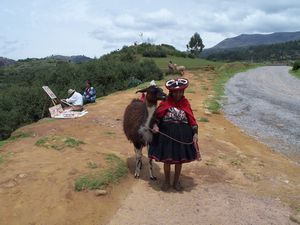Advertisement
Published: April 16th 2011

 Photo vendor
Photo vendor
On the heights above Cusco an Incan woman makes her living selling pictures of herself with her llama.The guide met us in the lobby. We had already checked out and eaten breakfast. Off to the airport for a short flight to Cuzco or as the Quachua spell it Cosco.
Another excellent flight on LAN. So far the airline has been spectacular in service and hospitality. Our guide, Carlos Sottomayor and our driver Jose, met us at the airport. Once loaded into the van it was off to Urubamba in the Sacred Valley. Carlos is a mixtos, his mother is Incan and his father of Spanish decent. He is a fount of information about the Sacred Valley and the Incan civilization. His depth of knowledge and clarity of explanation were as if listening to an historian and an anthropologist. Later the archaeologist in him would appear.
The trip to Urubamba from Cosco starts with a long climb out of an already high-altitude valley. The trip winds up through neighborhoods that clearly show the depth of the poverty in this region. The contrast between Cosco and Lima is striking.
Cosco is the economic center of the native lands of Peru. Fifty-per cent of the economy of this city and surrounding areas relies on tourism. But a discussion
of Cosco will be for a later blog. This is about the trip to Pisac, Urubamba, and the Sacred Valley of the Inca.
A stop is made in a drive-off area high above Cosco with a clear view of the city below. The area is occupied by an Incan woman and her llama willing to pose for pictures for a fee. There is a local artist working on the heights as well with his wares available for purchase.
As the climb continues there is an excavation of an Incan site off in a stand of trees. There are many of these excavations under way in the region since nearly everywhere one looks there is evidence of the original Incan civilization. Further along the road there are more makeshift roadside markets set-up by native artisans to sell their wares.
As the decent begins into the Sacred Valley there is evidence of the severe floods that struck this region in January 2010. Homes were washed away, roads destroyed, and the train tracks were undermined and damaged. It was a major disaster to the region in loss of lives, livestock, land, and the all important tourist trade that was essentially

 Incan ruins
Incan ruins
One of the many sites under excavation by archeologists.shut-down for three months.
Along the road to Pisac there was a llama farm that is clearly set-up for tourists to learn about the varieties of indigenous animals used for their fur and meat. The most common of these animals is the llama and alpaca; less common is the vicuna. These animals grow coats that are very much like sheep’s coats; soft, warm, and functional for the spinning of yarn for knitting and weaving a variety of apparel.
We will make a stop here to explore the llama farm before continuing our descent into the Sacred Valley near Pisac and then on to Urubamba.
Advertisement
Tot: 0.063s; Tpl: 0.017s; cc: 7; qc: 45; dbt: 0.0323s; 1; m:domysql w:travelblog (10.17.0.13); sld: 1;
; mem: 1.1mb

 Photo vendor
Photo vendor
 Incan ruins
Incan ruins


